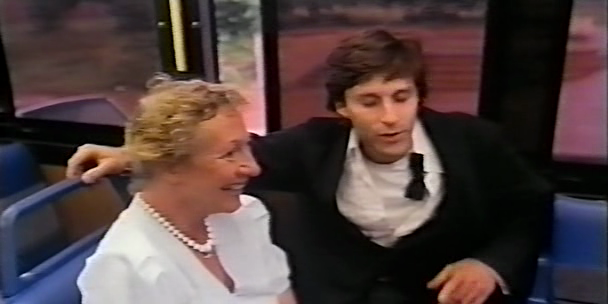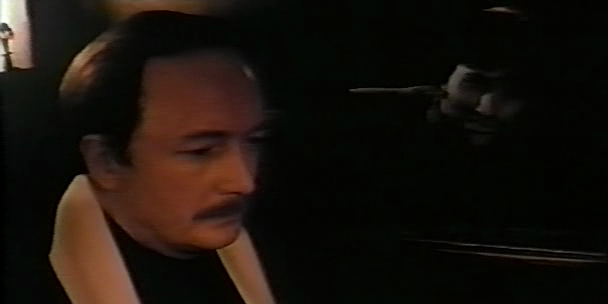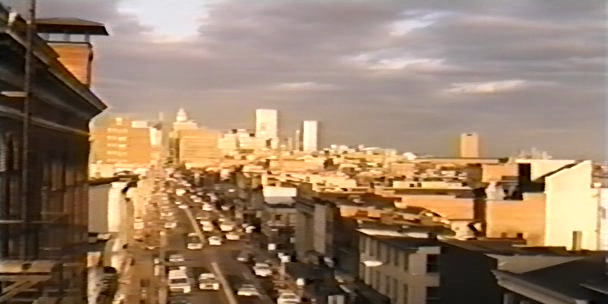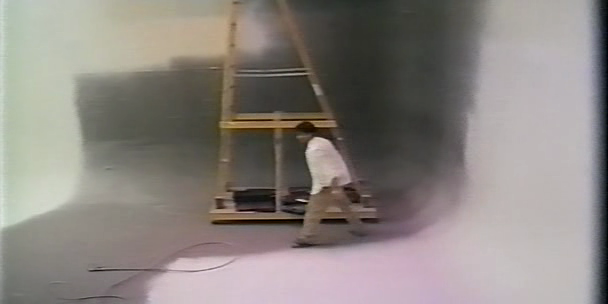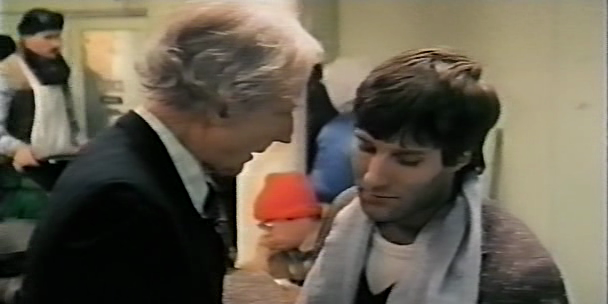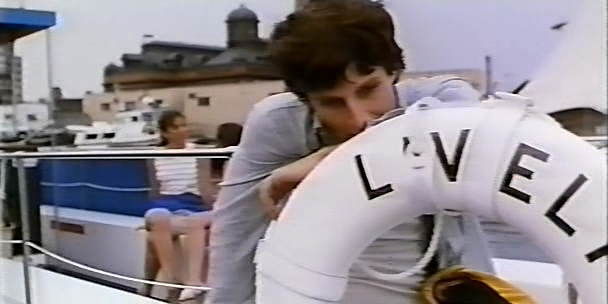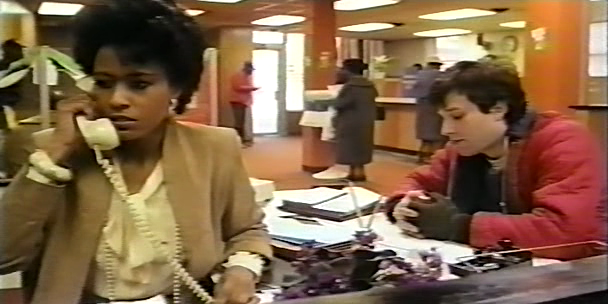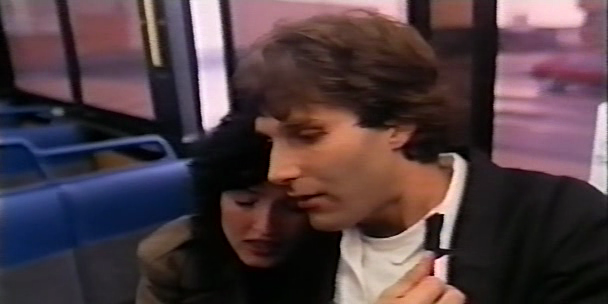From the November 4, 1988 issue of the Chicago Reader. This piece is also reprinted in my first collection, Placing Movies.
The absence of Rob Tregenza’s three features — Talking to Strangers, The Arc, and Inside/Out— on DVD continues to be a major cultural gap, although he says that does have plans to release them all when he can. (Regarding Inside/Out, here are two more links.) And there’s a fourth feature that he shot more recently in Norway, called Gavagai, which was shown in Chicago at Facets.
Before Godard produced Tregenza’s third feature, Inside/Out, he selected Talking to Strangers as his “critic’s choice” for the Toronto International Film Festival and even wrote an extended review of it for their catalog, the same year that he showed For Ever Mozart; I interviewed him about Histoire(s) du cinema at the same festival after he showed me the three latest episodes in his hotel room. — J.R.
TALKING TO STRANGERS
**** (Masterpiece)
Directed and written by Rob Tregenza
With Ken Gruz, Marvin Hunter, Dennis Jordan, Caron Tate, Henry Strozier, Richard Foster, Linda Chambers, and Sarah Rush.
Let us consider this waiter in the cafe. His movement is quick and forward, a little too precise, a little too rapid. He comes toward the patrons with a step a little too quick. He bends forward a little too eagerly; his voice, his eyes express an interest a little too solicitous for the order of the customer. . . . All his behavior seems to us a game. He applies himself to chaining his movements as if they were mechanisms, the one regulating the other; his gestures and even his voice seem to be mechanisms; he gives himself the quickness and pitiless rapidity of things. He is playing, he is amusing himself. But what’s he playing? We need not watch long before we can explain it: he is playing at being a waiter in a cafe. — Jean-Paul Sartre, Being and Nothingness
As it happens, Sartre’s waiter makes his guest appearance in the midst of a discussion about “patterns of bad faith.” Let’s assume, for our present purposes, that we’re all playing at being philosophers in relation to a particular pattern of bad faith (“a lie to oneself”) known as the movies, specifically the activity of watching movies. Movies, in the everyday sense of the term, are staged fictions, and the everyday activity of watching movies entails lying to oneself in order to participate in these fictions.
To say that watching a movie is a form of bad faith is not necessarily to condemn that activity, either morally or philosophically. The presumption that movies are an art implies that they entail telling a lie to oneself that ultimately leads to a form of truth; and on some level, if we’re sophisticated adult spectators, we always know that there’s a lie involved in the experience. We know, for example, that we’re watching 24 frames per second rather than a continuous, ongoing event, and that Orson Welles and Charles Foster Kane are not one and the same person, even if we agree to accept these fictions (among others) for a couple of hours. Yet by participating in this form of knowing and not-knowing, we share in some of the “bad faith” of role-playing pursued by the movie and the actors. Just as Sartre’s waiter plays at being a waiter, and Orson Welles plays at being Citizen Kane, we play at being spectators — to our advantage and our peril.
Part of the presumption of Rob Tregenza’s Talking to Strangers (which is showing this weekend at the Film Center) is that when strangers meet, they immediately and automatically fall into a kind of role-playing, a form of lying. But one of the many radical differences between this movie and most others is that it doesn’t establish any privileged source of truth about its characters’ identities in order to allow us to measure the extent of their lying. We see what these characters do, but we remain strangers to who and what they are, just as they remain strangers to one another. When we see a priest in a confessional (Henry Strozier), we know that he is a priest, but all we know about how he relates to being a priest is what he says and does; the rest of his identity remains inaccessible to us.
If one of the earmarks of a groundbreaking work is its capacity to confound and/or challenge existing categories and assumptions, Tregenza’s first feature qualifies on several counts. Frankly and audaciously “experimental” — in the original rather than the generic sense of that term — it is shot in wide-screen 35-millimeter and direct Dolby sound, implicitly inviting us to experience it as a movie in a theater, not as a film in an austere screening space. Financed and photographed by the writer-director himself, a Baltimore resident who raised the money by making TV commercials, it combines the rigors of elaborate preplanning with the bold risk taking of an aleatory event.
The movie consists of nine ten-minute takes, each of which features elaborately choreographed camera movements and an intricately calculated mise en scene; and while all of these sequences were carefully rehearsed, Tregenza insisted on shooting each of them only once. His basic rule was that each segment would consist of ten minutes of uncut film (all that would fit in the camera), and the one time he encountered a technical difficulty (during the first 90 seconds of a scene mainly set inside a potter’s studio) he used only the remaining footage, so this particular shot runs for only eight and a half minutes. This adoption of a virtual one-to-one shooting ratio is central rather than incidental to the film’s premise. Like the 35-millimeter film and the stereo sound recorded direct, it aims to maximize a sense of performance and presence and involve us fully in the contours of an event rather than oblige us to regard its idealized representation as we would in a Hollywood movie. All nine shots feature the same young man, Jesse (Ken Gruz); he is alone in the first and last shots and confronting one or more other people — talking to strangers — in the intervening seven; due to the present-tense quality of the shooting, the sense of confrontation is just as strong between the audience and the screen as it is between Jesse and the various people that he encounters. The movie itself, in other words, is “talking to strangers” with the same uncertainty, ambiguity, disequilibrium, and suspense that are generated between Jesse and the other characters.
Equally important to the movie’s premise, and in striking contrast to the eight ten-minute takes that make up Hitchcock’s Rope (1948), is that Tregenza’s nine shots are nonsequential and discontinuous. The placement of the first and last shots, when Jesse is alone — walking for several blocks through the busy streets of downtown Baltimore in the first, and spray-painting an enclosed interior white in the last — was predetermined, but the order of the other seven was dictated by chance operations. This means that while each shot has a distinct narrative exposition regarding character as well as the scene’s unfolding space, and each “tells a story,” the movie as a whole is a string of isolated episodes that don’t tell a single story.
The result of these procedures isn’t a puzzle, but it does engage the spectator in a kind of game. The overall project of Talking to Strangers is existential — the game of defining and interpreting the reality of an event while it’s unfolding without the safety net (i.e., focus or frame) of a narrator, viewpoint, or authorial voice. And in order to play this game, the spectator has to play a creative and participatory role and supply his or her own interpretive safety net, a “reading” of the events, This is not a game that can be won, but rather a dance of shifting accommodations and hypotheses — a bit like some of the challenges and invitations offered by life — that can be performed either well or badly. Since virtually all of the characters in Talking to Strangers, Jesse in particular, perform this dance badly, the stakes are increased, challenging us to understand the events better than they do.
One way of interpreting this challenge is to regard Tregenza’s movie as a kind of shaggy-dog comedy, as Barbara Scharres suggestively does in her notes on the film in the November Film Center Gazette: “Jesse (Ken Gruz), a would-be writer, wanders the urban landscape like a particularly obnoxious graduate student in search of the experiences that will inspire his art. Meet one of the all-time screen jerks — impossible to like, yet thoroughly fascinating, appallingly funny, and finally pathetic in the impermeable self-centered denseness with which he encounters the world.” While this is plausible as an after-the-fact impression of the film, it can only function intermittently while we’re watching it, because the film can only suggest without confirming some of the hypotheses that make this reading possible.
Indeed, part of the trickiness of Tregenza’s game is that Jesse’s identity — as well as our relation to it –seems to shift from one sequence to the next. In the first, we follow his restless movement over several city blocks, including his nearly boarding three separate buses. In the second, a theatrical, pontificating regular at a soup kitchen — a character known as the General (Marvin Hunter) — engages Jesse in conversation and asks him what he does. After facetiously replying that he’s a brain surgeon, Jesse says that he’s a writer, and the General immediately leaps to the conclusion (which Scharres shares) that he’s at the soup kitchen in search of material — a notion that gets the General so angry that he calls Jesse a “spy”, and indignantly gets a friend to eject him from the place. But Jesse insists that he’s there because he’s hungry, and in this scene, at least, we have no firm basis for doubting his word.
In the third sequence, shot on a riverbank, Jesse has a camera and a car, and claims to a stranger who pesters him (Dennis Jordan) that he’s scouting locations for a fashion magazine; in the fourth, he’s seeing a loan officer (Caron Tate) in a bank about paying back a college loan. But in later sequences, he describes himself variously as someone who’s never been to college, as someone who’s only passing through town and doesn’t live there, and as a local waiter; and in a sequence on a taxi boat, where he appears to be either drunk or stoned and unemployed, he seems to be as presumptuous about labeling some fellow passengers as the General was about labeling him in the soup kitchen. In short, while we can easily conclude from the movie as a whole that Jesse is a compulsive bullshit artist we can never fully determine which identities are real and which are assumed (including whether he’s a real or would-be writer); and most of the other characters in the movie are comparably unfixed. All that we know with any ceriainty is each of the events that Jesse and the others are involved in.
Needless to say, this makes it difficult to identify with any of the people in the movie, and I must admit that Talking to Strangers is a movie for viewers who are more likely to identify with a film’s maker than with any of its characters. This may help to explain why this picture — which was enthusiastically and perceptively praised by both Dave Kehr in the Tribune and John Powers in the L.A. Weekly when it was shown at the Berlin film festival last winter — has been systematically rejected by every American film festival and distributor and every New York screening venue it has been submitted to. Luckily, it turned up at the Toronto Festival of Festivals in September, where I was able to see it twice, and it has subsequently been shown in Baltimore and Los Angeles, but as far as I know, this has so far represented the sum of its screenings in North America prior to its arrival in Chicago.
It is clearly a movie that divides audiences, and one should add that Tregenza’s decision to make it in 35-millimeter and Dolby automatically excludes it from certain alternative venues that it might otherwise have had. But the importance of this utopian gesture in relation to the ghetto classification of most experimental films — Tregenza’s insistence on making a movie (he is planning to shoot his next feature in a ‘Scope format) — can’t be overestimated. And like much of the best innovative work, it arguably alters some of our criteria for judgment and description by showing us to what extent these criteria are founded on certain unexamined habits of film viewing.
A “masterpiece” is generally the work of a master, but the mastery of Talking to Strangers can’t be broken down into the usual Oscar categories. Tregenza’s cinematography is masterful by even the most conventional standards, though his dialogue and direction of actors simply are not. But what do we mean by “masterful” dialogue and acting? What we usually mean, I think, is dialogue and acting that are eloquent, witty, lucid, and believable, and that collectively “say something” in terms of a given reality.
This movie, however, is not interested in “saving something,” or in constructing any particular forms of elegance, wit, lucidity, or believability in terms of any given reality, apart from what the camera and microphones capture. It is interested in doing something, and any statement that arises from this act has to come from the spectator, contemplating a reality that is not so much given as jointly constructed, by the movie and the spectator working together — just as the various strangers in the movie are working together to create any reality (or lack of same) that they happen to share.
What this means in practical terms is that the acting styles are often divergent, and that the dialogue, which has fleeting moments of elegance, wit, and lucidity, seldom exists in a context where these moments or qualities are shared by any two or more characters onscreen. The two most remarkable and action-packed sequences, which are set in a bank and on a bus, are both in fact terrifying in the degree to which they exhibit strong emotions and attitudes that are unshared, portraying an unsettling view of America as an extended lunatic fringe.
In the bank, a woman working as a loan officer is driven to a nervous collapse by the competing and overlapping demands of an irate customer, a bank manager, and her husband or lover, who repeatedly calls her on the phone. (For once, Jesse figures here as the sanest active character — another customer who becomes a bemused but sympathetic spectator.) The scene’s overall thrust is realistic, but there’s a brief moment or two in the timing of Caron Tate’s otherwise believable performance as the loan officer — when she becomes hysterical and throws her phone receiver down — that registers as false. (We eventually learn from her dialogue that her lover’s calls and her hysteria are both related to her recently having had an abortion, but that’s all we find out about her.) The contrived moment in Tate’s performance — assuming that we all identify it as such — complicates the scene’s tension by making us aware of the actress as actress, but in no respect does it detract from the scene’s power and our own uneasy relation to it; it merely adds another level of uncertainty to our response.
The scene on the bus, the most complex and disturbing in the movie, begins as a conversation between Jesse and a middle-aged woman from Pennsylvania who has just boarded without the correct change, which Jesse supplies. Suddenly, a female punk named Trigger (Linda Chambers) enters the bus through the rear door and pulls out a gun. She’s followed by her boyfriend, Slick (Richard Foster), and three other raucous males, who proceed to beat the driver unconscious, take over the wheel, and drag the middle-aged woman to the back of the bus and rape her in turn. The gang rape is glimpsed only peripherally and periodically at the edge of the screen while the camera focuses on Slick forcibly engaging Jesse in a kind of mock-Platonic dialogue about society, morality, and violence, with interjections from Trigger, who is meanwhile reading a book about astronomy.
Slick’s nihilistic, quasi-intellectual discourse, which includes allusions to Freud and a proposal to force Jesse to participate in the gang rape –a nd is briefly interrupted by his cutting Jesse’s shoulder with his knife — is eventually taken over by Trigger. Slick suggests that she participate in the rape as well and then moves to the back of the bus. She questions Jesse about homosexuality and then delivers a monologue about a hypothetical situation in which Jesse might rape a woman without witnesses or fear of reprisal. Jesse replies, “I’d require her to love me first,” and Trigger calls him a “dinosaur.” Slick then returns and tries to get Trigger to join in the rape; she shoots Slick in the belly, asks Slick and Jesse in turn at gunpoint whether they love her (Slick says yes, Jesse no), and the scene ends with another, offscreen gunshot.
The acting of this sequence is virtually flawless, as is the cinematography and direction (if one excepts the slight miscalculation in timing that prohibits our view of the final gunshot). The Dostoyevskian extravagance of the dialogue, on the other hand, while central to the scene’s brilliance and horror, is so out of keeping with the relative verisimilitude of the rest of the film that it pushes Tregenza’s philosophical and phenomenological project to its limits. So much happens within the space of ten minutes — even more than I’ve recounted here — we may feel afterward that we’ve just lived through an entire feature, in contrast to the minimal amount of incident in many of the other sequences.
A veritable anthology of Sartrean bad faith, social slights, and egocentric misapprehensions, Talking to Strangers repeatedly implicates the viewer in its awkward, fractured encounters by emphasizing the rawness and potential wildness of every event –an anything-can-happen feeling that is akin to some of the best jazz improvisations. Much as jazz presupposes a freedom to make mistakes, the movie assumes a fallibility in human interactions that has its comic as well as tragic side, for the hapless spectators as well as the people onscreen.
Rather like Tati’s Playtime — the supreme “open” narrative work in movies that treats viewers and characters alike as distracted tourists — Talking to Strangers both offers and addresses itself to a gaggle of pontificators, theorists, and con artists who all play at constructing reality and themselves, at the same time and in the same gestures. While Tregenza’s sense of play is decidedly less sunny than Tati’s, its feeling of adventure still calls to mind Charlie Parker’s parting words to the father of existentialism when the two of them met in 1949: “I’m very glad to have met you, Mr. Sartre. I like your playing very much.”

